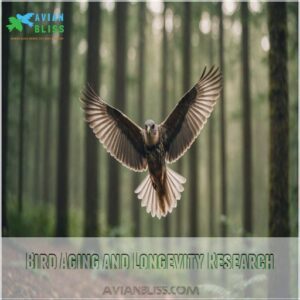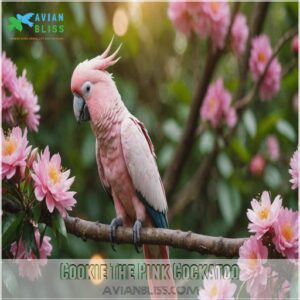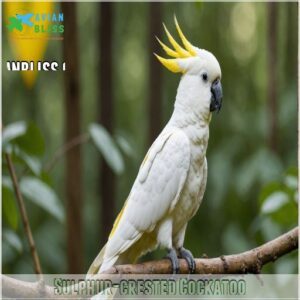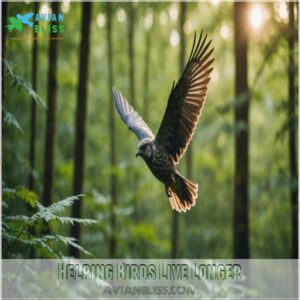This site is supported by our readers. We may earn a commission, at no cost to you, if you purchase through links.

However, many birds boast surprisingly long lives.
Take the Laysan albatross, clocking over 40 years and some surpassing 65!
Then there are parrots, the social butterflies of the avian world, living up to 50 years.
Meanwhile, your backyard hawks keep it modest at around 5 to 15 years.
Factors like genetics, environment, and diet all play key roles in these numbers.
Who knew bird-watching could lead to recognizing long-term relationships?
Stick around for more feathered insights that just might surprise you!
Table Of Contents
- Key Takeaways
- What Determines a Bird’s Lifespan
- Average Lifespan of Different Bird Species
- Factors Affecting Bird Longevity
- Bird Aging and Longevity Research
- Longest-Lived Bird Species on Record
- Helping Birds Live Longer
- Common Threats to Bird Lifespan
- Tips for Increasing Your Pet Bird’s Lifespan
- Frequently Asked Questions (FAQs)
- How long do birds live?
- What birds have a long life span?
- What is the average lifespan of small bird species?
- What birds live the longest?
- Which bird has the longest lifespan?
- What bird can live up to 100 years?
- Which bird has the shortest lifespan?
- What makes birds live so long?
- Do birds live longer in the wild or captivity?
- How do seasonal changes affect bird lifespan?
- Can diet impact a birds longevity?
- Do climate factors influence bird lifespan?
- What role does genetics play in bird longevity?
- Conclusion
Key Takeaways
- You’re exploring bird lifespans and realize size, genetics, and environment significantly impact how long they live, with larger species often outliving the smaller ones.
- Remember, birds in captivity tend to live longer than their wild counterparts due to protected environments, consistent food supply, and absence of predators.
- Keep in mind that climate change and environmental shifts alter food sources and habitats, affecting bird longevity. These changes can be tough on migratory and climate-sensitive species.
- Providing a nutritious diet and creating a safe, stimulating environment for pet birds can significantly extend their lifespans, ensuring they thrive for years.
What Determines a Bird’s Lifespan
You’ll find that a bird’s lifespan isn’t just luck of the draw.
It’s shaped by a complex interplay of genetics, environment, diet, and the daily game of survival against predators and diseases.
Genetics and Evolution
Over millions of years, birds have evolved to adapt to various environments, impacting their lifespans.
Genetic diversity plays a key role in determining how long different bird species live.
Some birds have developed mutations that slow aging, while others have genetic traits that help them resist diseases.
These evolutionary pressures have shaped the wide range of lifespans we see across bird species today.
Environmental Factors
While genes play a role, the world around birds shapes their lives too. You’d be surprised how much their surroundings affect how long they’ll stick around!
- Habitat loss shrinks their homes and food sources
- Climate change messes with migration patterns
- Pollution weakens their health and damages ecosystems
- Predator populations can boom or bust, changing survival odds
It’s like a game of survival out there!
Birds in captivity often outlive their wild cousins, thanks to a cushy life free from these environmental rollercoasters.
Diet and Nutrition
You are what you eat, and for birds, this saying couldn’t be truer.
A balanced diet is essential for a bird’s lifespan.
Different species have unique nutritional needs, but generally, a mix of seeds, fruits, and insects keeps them flying high.
Let’s peek at some bird buffet favorites:
| Food Type | Benefits | Examples |
|---|---|---|
| Seeds | Energy-rich | Sunflower, millet |
| Fruits | Vitamins | Berries, apples |
| Insects | Protein | Mealworms, crickets |
| Nectar | Quick energy | Flower nectar, sugar water |
Proper nutrition boosts immunity, supports feather health, and fuels those long migrations.
It’s like bird superpower juice!
Predation and Disease
Nature’s dance of survival plays out in the skies.
Birds face constant threats from predators and diseases, shaping their lifespans.
Hawks swoop down on unsuspecting songbirds, while avian flu can decimate entire flocks.
But our feathered friends aren’t defenseless.
They’ve evolved clever strategies to outsmart predators and boost their immune systems.
It’s a high-stakes game of hide-and-seek, where staying healthy and one step ahead means living to chirp another day.
Average Lifespan of Different Bird Species
You’ll be amazed at the wide range of lifespans in the bird world, from tiny hummingbirds living just a few years to majestic albatrosses soaring for decades.
Let’s explore the average lifespans of different bird species and uncover some surprising facts about our feathered friends’ longevity.
Small Birds and Songbirds
Fluttering through life, small birds and songbirds typically live 3 to 5 years.
Some bird species, like the White-crowned Sparrow, which faces habitat loss and climate change factors affecting their populations, have their short lifespans are influenced by factors like migration patterns and nesting behavior.
Cardinals may reach 6 years, while hummingbirds can buzz around for up to 5 years.
Food sources and winter survival skills play major roles in their longevity.
Despite their brief lives, these feathered friends contribute greatly to bird population dynamics and showcase unique species characteristics.
Waterfowl and Seabirds
Many waterfowl and seabirds boast impressive lifespans.
Ducks typically live 5-10 years, but some species can reach 20.
Seabirds, like albatrosses, often live decades due to their diving adaptations and migration patterns.
Coastal threats and conservation status impact their longevity.
Food sources play a key role in bird ecology and reproduction.
Notably, the oldest known wild bird is Wisdom, a Laysan Albatross estimated to be over 70 years old!
Birds of Prey and Raptors
Birds of prey soar above the rest in terms of longevity.
These aerial hunters, with their razor-sharp talons and keen eyesight, often live 20-30 years in the wild.
Eagles and falcons top the charts, thanks to their impressive hunting techniques and adaptations for flight.
Many bird owners also invest in products that cater to their bird’s age, such as those found in a bird age store Bird Supplies Online.
But it’s not all smooth sailing – conservation challenges like habitat loss and human interference can clip their wings.
Their diet of fresh prey and strategic nesting behavior contribute to their impressive bird lifespan records.
Parrots and Large Birds
Throughout their lives, parrots and large birds often outlive their smaller feathered friends, with some species like the gentle Hyacinth Macaws lifespan reaching impressive ages of up to 50 years. These intelligent creatures can live for decades, with some species reaching impressive ages.
Here’s what you need to know about their longevity:
- Parrots in captivity can live 50+ years with proper care
- Wild parrots typically have shorter lifespans due to environmental challenges
- Factors like diet, habitat, and genetics play key roles in their longevity
You’ll be amazed at how these chatty companions can become lifelong friends!
Factors Affecting Bird Longevity
You’ll find that a bird’s lifespan isn’t just about genetics; it’s a complex interplay of environmental factors.
From habitat quality and migration patterns to human activities and climate change, these elements shape the longevity of our feathered friends in ways that might surprise you.
Habitat and Migration
Now, let’s explore how a bird’s home sweet home and yearly journeys shape its life story.
You might think migration’s just a fun vacation, but surprisingly, even urban sparrows that don’t migrate often outlive their rural counterparts due to abundant food sources like House sparrows living up to 12 years. It’s a real game-changer for our feathered friends’ lifespans.
Here’s a quick peek at how different habitats and migration patterns affect bird longevity:
| Habitat Type | Migration Pattern | Impact on Lifespan |
|---|---|---|
| Tropical Forests | Non-migratory | Generally longer |
| Arctic Tundra | Long-distance | Often shorter |
| Temperate Woodlands | Short-distance | Moderate |
| Urban Areas | Adaptable | Varies widely |
Human Interference and Pollution
Humans cast a long shadow over bird longevity.
You’ll find plastic pollution choking waterways and oil spills coating feathers.
Habitat loss shrinks breeding grounds, while pesticides poison food sources.
Light pollution disorients migrating flocks, and noise disrupts key communication.
It’s like we’re unwittingly setting up obstacles in their flight path.
But there’s hope – by reducing our footprint, we can help our feathered friends soar to ripe old ages.
Disease and Parasites
While human-made threats loom large, birds also face invisible foes.
Disease and parasites can clip a bird’s wings, so to speak.
From salmonellosis to aspergillosis, these silent killers don’t discriminate.
Coccidiosis and trichomoniasis are no picnic either.
But don’t lose hope!
With proper prevention methods and timely treatment options, you can help our feathered friends stay healthy.
Remember, a clean bird feeder is like a mini bird hospital – it keeps the doctor away!
Climate Change and Weather
Climate change throws a curveball at our feathered friends’ longevity.
Extreme weather events can ruffle their feathers, impacting migration patterns and food availability.
You’ll notice birds adjusting their breeding schedules, sometimes with mixed results.
The Laysan Albatross, known to live up to 68 years, is just one example of a species struggling to cope with these changes.
As habitats shift, some species struggle to find suitable nesting spots.
It’s like nature’s game of musical chairs, and not every bird finds a seat when the music stops.
Bird Aging and Longevity Research
You’ll be amazed by the secrets scientists are uncovering about bird aging and longevity.
From studying wild birds to observing captive specimens, researchers are piecing together clues that reveal why some birds live longer than others.
Studying Bird Lifespan in The Wild
Tracking birds in their natural habitats isn’t a walk in the park.
You’ll find researchers using clever methods like bird banding to study lifespans.
They’re attaching tiny trackers to songbirds, hummingbirds, and even majestic eagles.
These tools help uncover survival rates and habitat impacts.
It’s like detective work in the wild, piecing together data to reveal that some bird species, like the Canada goose, can live up to Canadian goose lifespan, to reveal the secrets of how long our feathered friends live.
Ever wonder how an owl celebrates its birthday?
Bird Aging in Captivity
Captive birds often outlive their wild counterparts, thanks to controlled environments and dedicated care.
You’ll find that a proper captive bird diet, stress reduction, and disease prevention play key roles in extending their lives.
Captive breeding programs have made strides in preserving endangered species, while enrichment activities keep birds mentally sharp and physically active.
It’s like giving them a spa day every day – minus the cucumber slices for their eyes!
Longest-Lived Bird Species
While captive birds often outlive their wild counterparts, some species push the boundaries of longevity in both settings.
You’ll be amazed to learn about Wisdom, a Laysan Albatross who’s still laying eggs at 71!
Cookie, a Pink Cockatoo, held the record at 83 years.
Even in the wild, Andean Condors can reach 50-plus years.
These long-lived birds challenge our understanding of aging and spark curiosity about the secrets to their remarkable lifespans.
Clues to Bird Longevity
Scientists have uncovered several clues to bird longevity.
Bird size matters; larger species often live longer.
Surprisingly, despite high metabolism rates, many birds outlive similar-sized mammals.
Careful nestling care and specific life history traits play key roles.
Habitat quality strongly impacts lifespan, with birds in safer environments thriving longer.
You’ll find that these factors intertwine, creating a complex puzzle of avian longevity that researchers are still piecing together.
Longest-Lived Bird Species on Record
You’ll be amazed by the incredible lifespans of some bird species, which far surpass our own.
From Wisdom the 70-year-old Laysan Albatross to Cookie the 83-year-old Pink Cockatoo, these feathered centenarians challenge our understanding of avian longevity.
Wisdom The Laysan Albatross
Soaring through the skies at 71 years old, Wisdom the Laysan Albatross defies expectations, rivaling the wandering albatross soaring techniques that allow some birds to cover vast distances with minimal effort.
You’d be amazed to learn she’s flown over 3 million miles, equivalent to six round trips to the moon!
This ocean navigator has mastered bird migration, raising 30-36 chicks in her lifetime.
Wisdom’s longevity challenges our understanding of aging in birds, proving that some species can thrive well into their golden years.
Cookie The Pink Cockatoo
You’ve heard of Wisdom, but let’s talk about Cookie, the pink cockatoo that ruffled some feathers in the bird world.
This feathered Methuselah clinched the Guinness record for the oldest bird, living to a jaw-dropping 83 years!
Cookie’s longevity left scientists scratching their heads about bird aging.
- Hatched in 1933, Cookie called Brookfield Zoo home for 82 years
- Outlived the average cockatoo lifespan by over six decades
- Maintained a vibrant personality and rosy plumage until his final days
Sulphur-crested Cockatoo
While not officially verified, the Sulphur-crested Cockatoo holds the unofficial record for longevity.
Cocky Bennett, a beloved Australian icon, reportedly lived to 120 years old.
These birds’ diet of seeds, fruits, and insects contributes to their longevity.
Their breeding habits and social behavior also play a role in their extended lifespan.
Conservation efforts are essential to guarantee that these chatty, long-lived birds continue to thrive in the wild for generations to come.
Philippine Eagle and Andean Condor
Let’s spread our wings and explore two more avian marvels: the Philippine Eagle and Andean Condor.
These majestic birds aren’t just eye-catching; they’re also record-breakers in longevity. The oldest captive Philippine Eagle reached a remarkable 50 years, while an Andean Condor soared to an impressive 80 years in captivity. Their longevity secrets might just ruffle your feathers!
- Awe-inspiring wingspans that make you feel small
- Piercing eyes that seem to look right through you
- Graceful flight patterns that leave you breathless
- Fierce hunting skills that command respect
- Endangered status that tugs at your heartstrings
Helping Birds Live Longer
You can play a major role in extending birds’ lives by creating a safe environment and providing essential resources.
From planting dense shrubs for shelter to offering food and water sources, your actions can greatly impact avian longevity and help our feathered friends thrive.
Creating a Safe Environment
Now that we’ve explored record-breaking bird lifespans, it’s time to roll up our sleeves and create safe havens for our feathered friends.
Transform your yard into a bird-friendly garden by planting native species for shelter and food.
Prevent window strikes with decals or screens.
Practice habitat conservation by leaving dead trees for nesting.
Keep predators at bay with strategically placed birdhouses.
Establish pesticide-free zones to protect birds from harmful chemicals.
Your efforts can make a world of difference!
Providing Food and Water Sources
You’ve set up a safe haven, but birds need fuel to thrive.
Providing food and water sources can turn your backyard into a bustling bird sanctuary.
It’s like running a 5-star restaurant for our feathered friends!
Here are three ways to keep your avian guests coming back for more:
- Install diverse bird feeders (tube, platform, suet)
- Offer a variety of seeds, nuts, and fruits
- Maintain clean, shallow water sources year-round
Remember, you’re not just feeding birds; you’re boosting their chances of a longer, healthier life.
Reducing Human Interference
While food and water are essential, reducing human interference is equally important for bird longevity.
You can make a big difference by addressing common threats, and understanding how long birds live can help inform these conservation efforts, such as learning more at resources on bird life expectancy.
Here’s a quick guide to help our feathered friends:
| Threat | Solution |
|---|---|
| Window strikes | Apply decals or UV-reflective film |
| Cat safety | Keep cats indoors or use outdoor enclosures |
| Habitat loss | Plant native species in your yard |
By tackling these issues, you’re giving birds a fighting chance to thrive and live longer lives.
Promoting Conservation Efforts
Championing conservation efforts can greatly boost bird lifespans.
By tackling habitat loss and climate change, you’re giving our feathered friends a fighting chance.
Here’s how you can make a difference:
- Embrace sustainable practices in your daily life
- Support responsible tourism that respects wildlife habitats
- Get involved in citizen science projects to help researchers track bird populations
Your actions, no matter how small, can create a ripple effect in protecting these amazing creatures for generations to come.
Common Threats to Bird Lifespan
You’ll be surprised to learn about the numerous threats that can shorten a bird’s life, from diseases like avian pox to human-caused hazards.
These challenges, ranging from infectious illnesses to environmental pollution, play a significant role in determining how long our feathered friends survive in the wild.
Avian Pox and Newcastle Disease
Silent threats lurk in the avian world.
Avian pox causes warty growths on birds’ skin, while Newcastle disease attacks their nervous system.
Both can seriously shorten a bird’s life.
Recognize avian pox symptoms like lesions on featherless areas.
For Newcastle disease prevention, maintain strict hygiene in aviaries.
Bird disease management involves quarantining infected individuals and disinfecting their environment.
Early detection and proper treatment are key to managing these outbreaks and preserving our feathered friends’ longevity.
Salmonellosis and Avian Influenza
Salmonellosis and avian influenza are serious threats to bird longevity.
These diseases can spread like wildfire, affecting both wild and domesticated birds.
You’ll want to keep an eye out for:
- Sudden bird deaths in your area
- Unusual behavior or lethargy in birds
- Decreased egg production in poultry
Prevention is key.
Keep feeders clean, practice good hygiene, and stay informed about local bird flu outbreaks.
Remember, healthy birds make for a thriving ecosystem!
Aspergillosis and Other Fungal Diseases
Fungal infections can be a real buzzkill for our feathered friends.
Aspergillosis, caused by Aspergillus mold, is a serious threat to bird health.
It’s like a sneaky invader, targeting their respiratory system.
You’ll want to keep your bird’s environment clean and dry to prevent these pesky spores.
Other fungal diseases can impact a bird’s lifespan too, so stay vigilant.
Early detection and proper treatment are key to keeping your winged pals healthy and chirping.
Human-Caused Threats and Pollution
Human-made hazards pose significant threats to our feathered friends’ longevity.
You’d be surprised how much impact we’ve on their survival.
From sprawling cities to farm fields, our actions often clip birds’ wings, so to speak.
Here’s a sobering list of human-caused threats: To learn more about the factors influencing bird lifespan, you can explore products and resources related to extending bird longevity.
- Habitat loss: Bulldozing forests for development
- Oil spills: Coating seabirds in deadly slicks
- Pesticide use: Poisoning birds and their food sources
- Light pollution: Disorienting nocturnal migrants
Climate change looms large, altering migration patterns and food availability.
It’s a wake-up call – we’re all in this nest together.
Tips for Increasing Your Pet Bird’s Lifespan
You can greatly extend your pet bird’s lifespan with proper care and attention.
From providing a nutritious diet to creating a safe environment, these tips will help your feathered friend thrive for years to come.
Providing a Nutritious Diet
Want to give your feathered friend a longer, healthier life? It’s all about the grub! A balanced diet is key to your bird’s longevity.
Mix up their menu with a variety of seeds, fruits, and veggies. Don’t forget to sprinkle in some protein-packed treats.
Here’s a quick guide to keep your birdie’s belly happy:
| Food Type | Examples |
|---|---|
| Seeds | Sunflower, millet |
| Fruits | Apple, berries |
| Veggies | Carrot, kale |
| Protein | Cooked egg, mealworms |
| Grains | Quinoa, oats |
Remember, moderation is the secret sauce in bird nutrition!
Practicing Good Hygiene and Health Care
After ensuring your bird enjoys a healthy diet, focus on hygiene and healthcare.
Regularly maintaining a clean bird bath is essential, as stagnant water can be a breeding ground for mosquitoes, so knowing how to clean a bird bath is essential.
Keep their environment pristine with these steps:
- Bird Baths: Provide regular baths to maintain feather health.
- Clean Cages: Daily cleaning prevents bacteria buildup.
- Vet Visits: Schedule routine check-ups for professional oversight.
- Parasite Control: Use safe methods to protect your feathered friend.
These actions create not just cleanliness, but longevity.
Monitoring for Signs of Illness
Keeping your feathered friend healthy means noticing changes.
A sudden drop in energy? That’s a red flag.
Is your bird eating less or fluffing its feathers excessively?
These are signs of distress, possibly indicating Common Bird Illnesses.
Don’t rely solely on Home Remedies; a Vet Check-Up is always best.
Early detection of Bird Behavior Changes, such as the Northern Cardinal’s fiercely territorial behavior in open woodlands, suburban garden habitats, can make all the difference in their health.
Regular observation is key to a long and happy life together.
Creating a Safe and Stimulating Environment
Spotting early signs of illness in your pet bird is key, but let’s not stop there!
Boost their health by crafting a sanctuary that’s both safe and exciting.
Think bird-friendly gardens and enrichment toys.
Make sure windows are safe to prevent mishaps.
Incorporate predator control and habitat restoration to create a thriving, playful environment they can call home.
Frequently Asked Questions (FAQs)
How long do birds live?
Birds’ lifespans vary widely based on size and species.
Smaller birds live around 3 to 5 years, while larger birds can exceed 15 years.
Captivity often extends longevity, with parrots sometimes living for decades!
What birds have a long life span?
Imagine a bird defying time.
Parrots, like the famous Cocky Bennett, seabirds such as albatrosses, and majestic raptors often outlive our expectations, soaring for decades.
Birds’ unique ability to efficiently capture and digest insects, thanks to their rapid immune response, Their long lives reveal nature’s secrets, keeping us guessing.
What is the average lifespan of small bird species?
Small birds, like robins and sparrows, typically live 3 to 5 years in the wild.
These brief lives are often packed with challenges, from dodging predators to surviving harsh weather, making each year a real adventure.
What birds live the longest?
Some birds, like certain parrots and albatrosses, are real Methuselahs! They can live for decades, even exceeding 80 years. Factors like predation and habitat influence their lifespan. Isn’t nature amazing?
Which bird has the longest lifespan?
Cookie," a Pink Cockatoo, holds the record for longest-lived bird, reaching 83 years.
It’s remarkable how these birds can outfly many of us on life’s highway.
That’s one impressive feathered friend strolling down the sands of time!
What bird can live up to 100 years?
Believe it or not, Cocky Bennett, a Sulphur-crested Cockatoo, reportedly lived up to 120 years!
While exceptional, it’s a feathered elder worth noting.
Most cockatoos don’t hit the century mark, but they sure live impressively long.
Which bird has the shortest lifespan?
Ever wondered which bird has the shortest lifespan?
It’s the hummingbird.
These tiny wonders typically live only 3 to 5 years.
They’re hardwired for speed, but those dazzling flights come at a cost—short shelf life.
What makes birds live so long?
Birds often live long lives due to their high metabolism and efficient systems that stave off aging.
Larger species live even longer, benefiting from fewer predators and less environmental stress, balancing their few offspring with longevity.
Do birds live longer in the wild or captivity?
In captivity, birds often outlive their wild counterparts.
Protected from predators, disease, and harsh weather, they enjoy steady meals and healthcare.
Wild birds face many threats, leading to shorter lifespans.
Consider keeping your feathery friend safe!
How do seasonal changes affect bird lifespan?
Imagine nature’s clock ticking through the stages of bird egg incubation, like quail eggs hatching in as little as 16 days for tiny eggs.
Seasonal changes impact birds by affecting food availability, temperature, and daylight.
These shifts can shorten lifespans by increasing stress, requiring adaptability to navigate challenges in their environments effectively.
Can diet impact a birds longevity?
Yes, a bird’s diet directly impacts its lifespan.
A balanced diet provides essential nutrients, boosting immunity and overall health.
Poor nutrition weakens them, making them vulnerable to disease and shortening their lives.
Do climate factors influence bird lifespan?
Rising temperatures, shifting seasons, and extreme weather weave a complex web that shapes bird lifespans.
They face habitat changes, altered food availability, and increased stress.
These factors can shorten their lives, impacting especially migratory and climate-sensitive species.
What role does genetics play in bird longevity?
Genetics largely shapes bird longevity, influencing traits like size and metabolism, which affect lifespan.
Larger birds usually live longer, like cockatoos, which famously reach ripe old ages thanks to their genetic makeup.
It’s all in their DNA!
Conclusion
Much like the elusive Laysan albatross soaring over the ocean for decades, exploring bird facts about their lifespan reveals a world of surprises in avian longevity.
From genetics to climate, each factor interweaves into the tale of survival and endurance.
By creating bird-friendly spaces and reducing human impact, you can foster these long-term avian connections.
Whether in the wild or as companions, ensuring a healthy environment helps these fascinating creatures thrive year after year.














